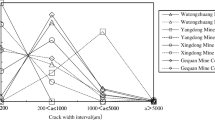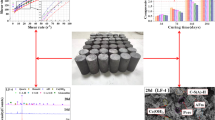Abstract
The Weng’an Biota, a fossil Konservat-Lagerstätte in South China that is c. 570 – 609 myr old, preserves the world’s oldest zoolite and provides a unique empirical record for studying animal origins and early evolution. Due to geological disasters caused by the exploitation of the local phosphate mine, part of the fossilized records and the geological sections of the Weng’an Biota have been seriously damaged. Protection of this unique fossil area is urgently required. In this research, an innovative scheme for the protection of the geological relics of the Weng’an Biota is proposed by backfilling the mine cavity with specially formulated grouting materials. In view of the shortcomings of the current grouting materials, such as the high proportion of water separation, the low stone percentage and high cost, newly developed grout materials consisting of mixtures of cement-fly ash-expansion agent (C-F-E) were systematically studied by a combined method of theoretical analysis and experimental study. Firstly, new grouting materials (C-F-E) were developed using selected proportions of (1) Portland cement (P·O 32.5), (2) external admixture (Fly ash), (3) expansion agent (NV) and (4) admixture (DFZ). Then, the properties of new grouting materials (C-F-E), such as stability, stone percentage, rheology, fluidity, setting time and compressive strength were evaluated by laboratory tests. Finally, a new model of the hydration process was proposed for these newly developed grouting materials based on a detailed scanning electron microscopy (SEM) study of their microstructural development. These research results will provide an effective solution to the protection of the geological relics of the Weng’an Biota. Additionally, these grouting materials may prove suitable for solving similar problems in the management of most mine cavities requiring stabilization in the future.
Similar content being viewed by others
References
Anagnostopoulos CA (2007) Cement-clay grouts modified with acrylic resin or methyl methacrylate ester: physical and mechanical properties. Construction & Building Materials 21(2): 252–257. https://doi.org/10.1016/j.conbuildmat.2005.12.007
Anagnostopoulos CA (2014) Effect of different superplasticisers on the physical and mechanical properties of cement grouts. Construction & Building Materials 50(1): 162–168. https://doi.org/10.1016/j.conbuildmat.2013.09.050
Azadi MR, Taghichian A, Taheri A (2017) Optimization of cement-based grouts using chemical additives. Journal of Rock Mechanics and Geotechnical Engineering 9(4): 623–637. https://doi.org/10.1016/j.jrmge.2016.11.013
Celik F, Canakci H (2015) An investigation of rheological properties of cement-based grout mixed with rice husk ash (rha). Construction & Building Materials 91(2015): 187–194. https://doi.org/10.1016/j.conbuildmat.2015.05.025
Chen L, Xiao S, Pang K, et al. (2014) Cell differentiation and germ-soma separation in ediacaran animal embryo-like fossils. Nature 516(7530): 238–241. https://doi.org/10.1038/nature13766
Dornbos S, Bottjer D, Chen JY, et al. (2006) Environmental controls on the taphonomy of phosphatized animals and animal embryos from the neoproterozoic doushantuo formation, southwest china. Palaios 21(1): 3–14. https://doi.org/10.2110/palo.2004.p04-37
El-Gamal SMA, Abo-El-Enein SA, Ahmed NED, et al. (2019) Effect of novel binaphthol derivative admixture on the hydration characteristics, rheological and mechanical properties of ordinary portland cement pastes. Advances in Cement Research 31(7): 331–342. https://doi.org/10.1680/jadcr.17.00051
Fu X, Wang Z, Tao W, et al. (2002) Studies on blended cement with a large amount of fly ash. Cement and Concrete Research 32(7): 1153–1159. https://doi.org/10.1016/S0008-8846 (02)00757-3
Hagadorn JW, Xiao S, Donoghue PCJ, et al. (2006) Cellular and subcellular structure of Neoproterozoic animal embryos. Science 314(5797): 291–294. https://doi.org/10.1126/science.1133129
He W, Fatehi P (2015) Preparation of sulfomethylated softwood kraft lignin as a dispersant for cement admixture. Rsc Advances 5(58): 47031–47039. https://doi.org/10.1039/C5RA04526F
Lasheras-Zubiate M, Navarro-Blasco I, J. M. Fernández, et al. (2011) Studies on chitosan as an admixture for cement-based materials: assessment of its viscosity enhancing effect and complexing ability for heavy metals. Journal of Applied Polymer Science 120(1): 242–252. https://doi.org/10.1002/app.33048
Li CW, Chen JY, Hua TE (1998) Precambrian sponges with cellular structures. Science 279(5352): 879–882. https://doi.org/10.1126/science.279.5352.879
Liu CY, Yang JX, Wu FF (2015) A proposed method of coal pillar design, goaf filling, and grouting of steeply inclined coal seams under water-filled strata. Mine Water & the Environment 34(1): 87–94. https://doi.org/10.1007/s10230-014-0314-4
Mirza J, Mirza MS, Roy V, et al. (2002) Basic rheological and mechanical properties of high-volume fly ash grouts. Construction & Building Materials 16(6): 353–363. https://doi.org/10.1016/S0950-0618 (02)00026-0
Sha F, Li S, Liu R, et al. (2018) Experimental study on performance of cement-based grouts admixed with fly ash, bentonite, superplasticizer and water glass. Construction & Building Materials 161: 282–291. https://doi.org/10.1016/j.conbuildmat.2017.11.034
Sugiarto L, Mavin KC (1986) The effects of a set retarding admixture on the dry density and compressive strength of a soil cement mix following delayed compaction. Thermochimica Acta 390(1–2): 83–91.
Tong LY, Pan S, Qiu Y, et al. (2002) Experimental study on filling material with large dosage of fly ash. Journal of Southeast University (natural science edition) 32(4): 643–647. (In Chinese) https://doi.org/10.3321/j.issn:10010505.2002.04.024
Twardowska I, Szczepanska J (2002) Solid waste: terminological and long-term environmental risk assessment problems exemplified in a power plant fly ash study. Science of the Total Environment 285(1): 29–51. https://doi.org/10.1016/S0048-9697(01)00893-2
Wang GY, Jiang ZQ (2017) Research and application of xanthan gum, a synchronic grouting material in shield tunnel. Modern Tunnel Technology 54(6): 223–226. (In Chinese) https://doi.org/10.13807/j.cnki.mtt.2017.06.030
Yin Z, Cunningham JA, Vargas K, et al. (2017) Nuclei and nucleoli in embryo-like fossils from the Ediacaran Weng’an biota. Precambrian Research 301: 145–151. https://doi.org/10.1016/j.precamres.2017.08.009
Yin Z, Zhu M, Tafforeau P, et al. (2013) Early embryogenesis of potential bilaterian animals with polar lobe formation from the Ediacaran Weng’an Biota, south china. Precambrian Research 225(1): 44–57. https://doi.org/10.1016/j.precamres.2011.08.011
Yin ZJ, Zhu MY, Davidson EH, et al. (2015) Sponge grade body fossil with cellular resolution dating 60 myr before the cambrian. Proc Natl Acad Sci USA 112(12): 1453–1460. https://doi.org/10.1073/pnas.1414577112
Zhang Z, Shimada H (2018) Numerical study on the effectiveness of grouting reinforcement on the large heaving floor of the deep retained goaf-side gateroad: a case study in China. Energies 11(4): 1001. https://doi.org/10.3390/en11041001
Zhou C, Li XH, Xiao S, et al. (2017) A new sims zircon u–pb date from the ediacaran doushantuo formation: age constraint on the weng’an biota. Geological Magazine 154: 1–9. https://doi.org/10.1017/s0016756816001175
Acknowledgments
This paper was supported by the National Natural Science Foundation of China (Grant No. 41672362) and the Key projects of Sichuan Provincial Department of Education (Grant No.16ZA0099) and the State Key Laboratory of Geohazard Prevention and Geoenvironment Protection (Grant No. SKLGP2017Z011).
Author information
Authors and Affiliations
Corresponding author
Rights and permissions
About this article
Cite this article
Wang, S., Shu, Zh., Guo, Kb. et al. Development of grouting materials with application to the protection of the geological relics of the Weng’an Biota. J. Mt. Sci. 16, 1962–1974 (2019). https://doi.org/10.1007/s11629-019-5394-y
Received:
Accepted:
Published:
Issue Date:
DOI: https://doi.org/10.1007/s11629-019-5394-y




